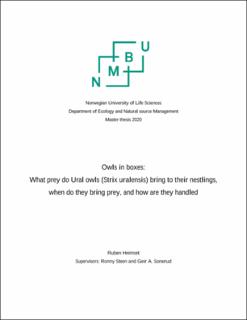| dc.contributor.advisor | Steen, Ronny | |
| dc.contributor.advisor | Sonerud, Geir A. | |
| dc.contributor.author | Heimset, Ruben | |
| dc.coverage.spatial | Sweden, Värmland | en_US |
| dc.date.accessioned | 2021-01-26T19:41:14Z | |
| dc.date.available | 2021-01-26T19:41:14Z | |
| dc.date.issued | 2020 | |
| dc.identifier.uri | https://hdl.handle.net/11250/2724861 | |
| dc.description.abstract | Earlier studies have investigated the feeding of owl nestlings through examining remains of animals in nests. In some species, like the Ural owls (Strix uralensis), this may give lacking information since they are known to remove these remains. The use of cameras may enable discovering of the subtleties in the feeding of Ural owl nestlings, more specifically the handling of different prey. I analyzed prey deliveries at 11 Ural owl nests located in Värmland county in Sweden and Hedmark county in Norway by use of video monitoring. All in all, 564 prey deliveries were registered, in which 465 of the prey were mammals, 60 were birds, 12 were frogs and 1 was a lizard. Prey deliveries were significantly lower than randomly expected from 8 hours in the morning to 17 hours in the evening and higher than expected from 18 in the evening, until 6 in the morning. Deliveries of mammals was higher than the average from 18 to 23 hours in the evening and from 3 to 6 hours in the morning. Deliveries of avian prey was higher than randomly expected from 22 hours in the evening to 3 hours in the morning. The male delivered prey directly to the female 74 times. The probability of this happening decreased as the age of nestlings increased and so did the probability of female assisting the nestlings with feeding. There are still discrepancies in this field and more similar studies should be done in other areas. | en_US |
| dc.language.iso | eng | en_US |
| dc.publisher | Norwegian University of Life Sciences, Ås | en_US |
| dc.rights | Attribution-NonCommercial-NoDerivatives 4.0 Internasjonal | * |
| dc.rights.uri | http://creativecommons.org/licenses/by-nc-nd/4.0/deed.no | * |
| dc.title | Owls in boxes : what prey do Ural owls (Strix uralensis) bring to their nestlings, when do they bring prey, and how are they handled | en_US |
| dc.type | Master thesis | en_US |
| dc.subject.nsi | VDP::Matematikk og Naturvitenskap: 400::Zoologiske og botaniske fag: 480 | en_US |
| dc.description.localcode | M-LUN | en_US |

